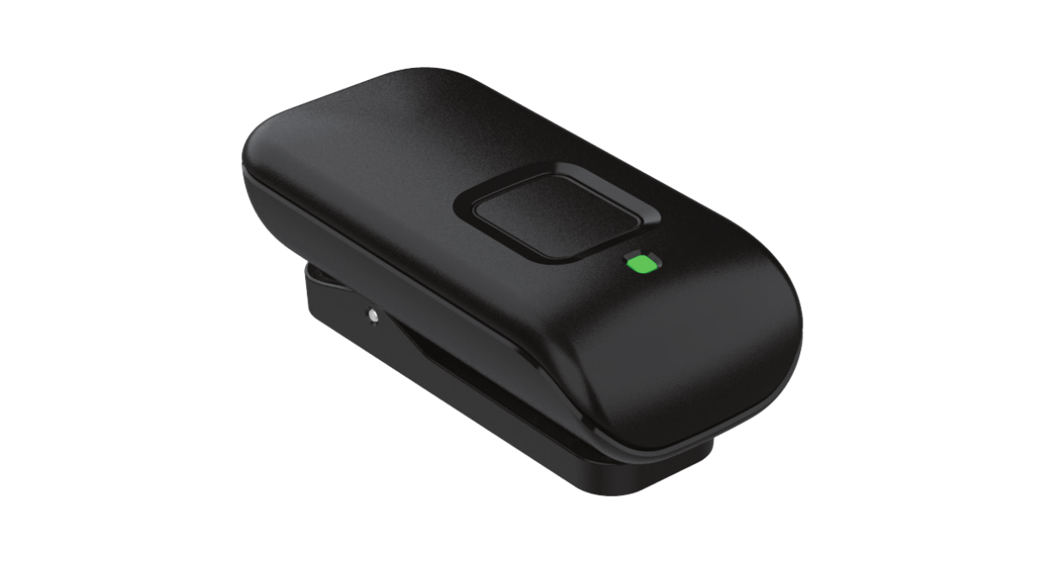
Mini Remote MicrophoneOPERATIONS MANUAL
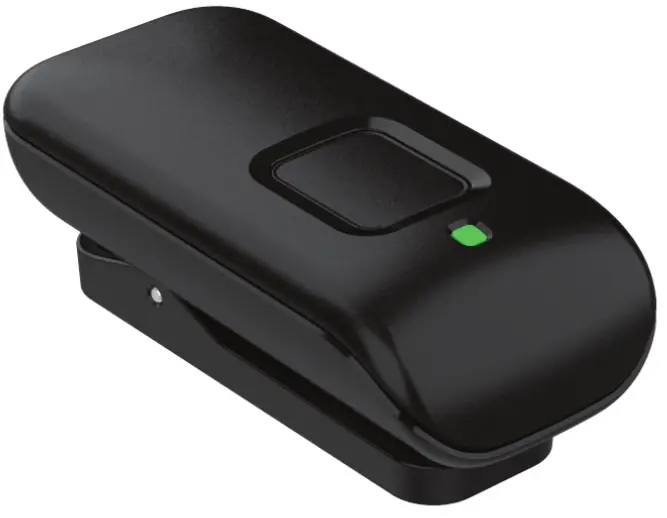
Overview
The Mini Remote Microphone is designed to stream remote microphone audio directly to your 2.4 GHz wireless hearing aids. When worn by a distant speaker in noisy environments, the Mini Remote Mic functions as an assistive listening device.Streaming - Audio or sound transmitted wirelessly from the Mini Remote Mic directly to your hearing aids.Package Contents
- Mini Remote Mic
- Power Adapter
- USB-to-micro USB cable
- Operations Manual
Optional Accessories
- Lanyard (part #91324-000)

- Power Button
- Status Indicator LED
- Microphone
- MicroUSB Jack
- Clip
Overview
- Power Button• Powers on and off the Mini Remote Microphone
- Status Indicator LED• Identifies the operational state of the Mini Remote Mic
LED
OPERATIONAL STATE
Off Power is off Slow Pulsing Green
Power is on Slow Pulsing Red Low battery condition Solid Red Possible fault condition - Microphone• Picks up speaker’s voice during use
- MicroUSB Jack• Recharges via USB-to-micro USB cable
- Clip• Affixes Mini Remote Mic to clothing or lanyard
Tip: Stream Volume can be adjusted via the Thrive Hearing Control app, the 2.4 GHz Remote and/or hearing aid user controls. Review your hearing aid operation manual or contact your hearing professional for details on your particular system setup.
Basic Use
- To turn on the Mini Remote Microphone, press the power button for 2 seconds and release it when the green LED appears.

- Ensure your hearing aids are powered on.• Note: Prior to streaming audio for the first time, your hearing aids will need to be paired to the Mini Remote Mic. Refer to Pairing with Hearing Aids on page 12.
- To start audio streaming,• Open the Thrive Hearing Control app and select Start Streaming from the Accessories screen.• Refer to Start/Stop Audio Streaming on page 15 for additional options.
- To adjust the stream volume, use the Thrive Hearing Control app, the 2.4 GHz Remote and/or hearing aid user controls.
- To stop streaming, do one of the following:• Turn off the Mini Remote Mic.• Open the Thrive Hearing Control app and select Stop Streaming from the Accessories screen.• Refer to Start/Stop Audio Streaming on page 15 for additional options.
Daily Use
| Power OnPress the power button for 2 seconds and release it when the LED illuminates. | 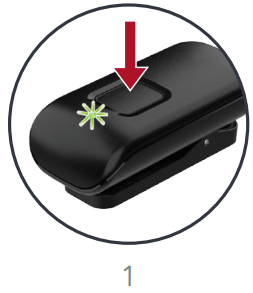   |
| Power OffPress the power button for 2 seconds and release it when the LED turns off. |   |
| Battery LowLED slowly pulses red. Provides an audible indicator tone to hearing aids every 5 minutes. | 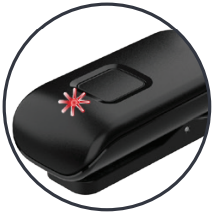  |
| Battery RechargeAttach the micro USB end of the charging cable to the micro USB jack on the Mini Remote Microphone. | `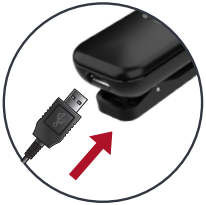  |
| Attach the USB end of the charging cable to a female USB jack on the enclosed power adapter. |   |
Recharging StatusThe Mini Remote Mic reaches a fully charged state typically in about 3 hours. It can reach a 50% charged state in about 1.5 hours.
| Power | Charge State | LED |
| Off | Recharging | Solid Green |
| Off | Complete | Off |
| On | Recharging | Solid green briefly interruptedby other LED status behaviors |
| On | Complete | Off |
Tip: Recharging the Mini Remote Mic can take longer while streaming audio. Recharging will be faster when the Mini Remote Mic is off.
Wearing the Mini Remote MicrophoneThe Mini Remote Microphone can be affixed to clothing or worn on a lanyard. The Mini Remote Mic should be within 8 inches (20 cm) of the speaker’s mouth.Clip Press the clip as shown. Slide clip opening onto clothing and release clip. Ensure the Mini Remote Mic is securely affixed to the clothing.Lanyard (optional)
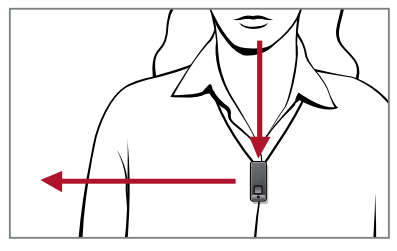

- Press the clip as shown.

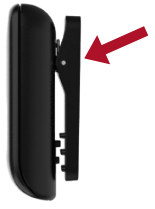
- Insert lanyard loop into clip opening and lift loop toward the top of the clip. Release clip. Ensure the lanyard is securely attached to the Mini Remote Mic.


- Place lanyard around the neck.
Pairing with Hearing Aids
For the Mini Remote Microphone to interact with your hearing aid(s), you must first pair the Mini Remote Mic with each hearing aid. You only need to perform this action one time, as they should automatically recognize each other when both are powered on and within wireless operating range.*
To pair the Mini Remote Mic with your hearing aid(s):
- Ensure your hearing aids are not connected to nearby Bluetooth® devices. To do this,• Disable Bluetooth on your mobile phone.• Power off any nearby 2.4 GHz TV, Remote Microphone +, or Mini Remote Mic accessories, which you previously paired to your hearing aids.
- Power off, then power on your hearing aids.• Note: For a CROS hearing aid system, power off both your hearing aid and CROS transmitter. Power on only your hearing aid, ensuring the CROS transmitter remains powered off.
- Place your hearing aids within 6 inches (15 cm) of the Mini Remote Mic.
- While the green LED is slowly pulsing, double-click the power button. The LED status indicator alternately blinks red and blue.

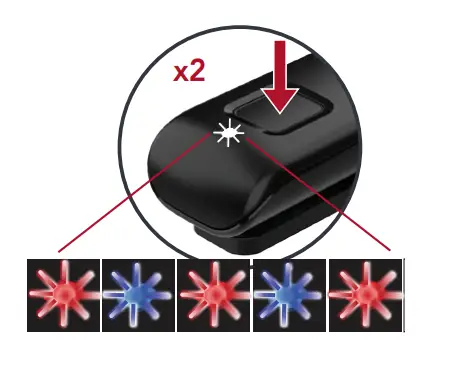
- For a set of hearing aids:
First LED blink Second LED blink Pairing Result Next Step 



Both hearing aidspaired Complete 




Only one hearing|aid paired Repeatsteps1 – 5 


n/a
No hearing aids paired Repeattips1 – 5 - For a single hearing aid:
| LED blink | Pairing Result |
Next Step |
| Successful | Complete | |
   |
Unsuccessful | Repeat steps 1 — 4 and 6 |
*Typical operating range is up to 20 meters (~60 feet). Operational range may be reduced by environmental factors, such as obstructions, interference and human body positioning. Larger operational distances are achievable, though audio quality and connectivity may decrease.
Using the Mini Remote MicrophoneIn its primary usage, the Mini Remote Microphone is worn by a distant speaker in noisy environments. This allows a hearing aid wearer to focus on one person when background noise is present.
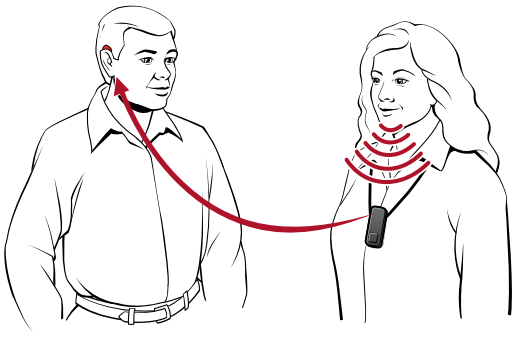
While not optimized as a general-purpose omnidirectional microphone for tabletop use, the Mini Remote Mic may still provide benefit in some circumstances. For example, try placing the Mini Remote Mic near a television. To achieve a comfortable listening level, adjust the Mini Remote Mic distance from the television speakers or modify the audio streaming volume level.
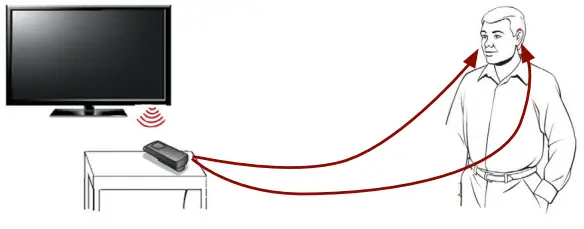

- Turn On the Mini Remote Mic: Audio streaming automatically starts in the hearing aid.
- Thrive Hearing Control app: Open the app on your mobile phone or tablet. Select the option to start/stop streaming from the Accessories screen.
- 2.4 GHz Remote: If preconfigured by your hearing professional, press the Favorite button.


- Hearing aid user control: If preconfigured by your hearing professional, a specific gesture (e.g., a Long Press on a user control) can start/ stop streaming.
Audio streaming will also stop when the Mini Remote Mic is turned off.
An audible indicator may play in your hearing aids to signal the start/stop of audio streaming.
Assembling the Power AdapterThe Mini Remote Microphone may include a variety of plug configurations for use in different countries. If the power adapter requires assembly:
- Select the appropriate plug configuration used in your country.

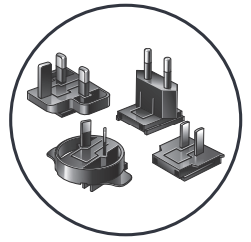
- Slide the plug onto the power adapter until it snaps into place.


- To remove the plug, press the tab and slide the plug away from the cable.

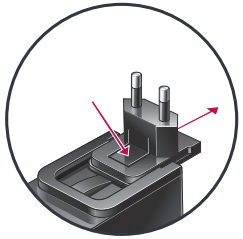
Troubleshooting
| SYMPTOM | POSSIBLE CAUSES |
SOLUTIONS |
| One (or both) hearing aids unexpectedlydrops out of audio streaming. | Hearing aids may be on the edge of wireless range. | Move closer to Mini Remote Mic. |
| The battery level in the hearing aid can no longer support audio streaming. | • Replace the hearing aid battery with a new one.
• Recharge your hearing aid, if applicable. |
|
| Large objects, such as furniture or a wall, may be a degrading signal. | For best performance, your hearing aids should be within line of sight of the Mini Remote Mic. | |
| Wireless connection with Mini Remote Mic was lost. | To restart the audio stream, follow the steps in the Start/ Stop Audio Streaming section. | |
| Low battery level in Mini Remote Mic. | Recharge Mini Remote Mic. | |
| Streamed audio quality is distorted. | Volume streamed from Mini RemoteMic to hearing aid not optimal. | Adjust the stream volume via Thrive earing Control the app, 2.4 GHz Remote, or hearing aid user controls. |
| The audio stream is too loud or too soft. | Mini Remote Mic may be too far from the speaker. | Move Mini Remote Mic closer to the speaker’s mouth. |
| Difficult to hear speakers in noisy environments. | Mini Remote Mic may be covered by clothing or poorly positioned. | Provide clear access from Mini Remote Mic to the speaker’s voice. |
| LED is slowly pulsing green, but no streamedsounds are heard in the hearing aids. | Hearing aids are not ready to receive audio streams. | To start the audio stream, follow the steps in the Start/ Stop Audio Streaming section. |
| Hearing aids are not paired with Mini Remote Mic. | Follow steps in the Pairing with Hearing Aids section. | |
| LED is solid red. | Possible error condition. | Turn off Mini Remote Mic, wait 30 seconds, and then turn it on. |
Safety Information
Required Information![]()
![]()
- Power off the Mini Remote Mic.
- Pry apart the housing halves with a small screwdriver.
- Cut the battery wires from the circuit board to prevent accidental shorting.
- Pry the battery away from the housing using a wide flat blade.
Intended UseThe Mini Remote Mic is an accessory to a 2.4 GHz wireless air conduction hearing aid. It is intended as a wireless transmitter of sound from an audiosource to air conduction hearing aids. When worn by a distant speaker in noisy environments, it functions as an assistive listening device. The Mini Remote Mic is classified as a Type B applied part under the IEC 60601- 1 medical instrument standard.The Mini Remote Mic is designed to comply with the most stringent Standards of International Electromagnetic Compatibility. However, it is still possible thatyou may experience interference caused by power line disturbances, airport metal detectors, electromagnetic fields from other medical devices, radio signalsand electrostatic discharges.The Mini Remote Mic is designed to be cleaned with a damp cloth moistened with soapy water.
If you use other medical devices or wear implantable medical devices such as defibrillators or pacemakers and are concerned that your Mini Remote Mic might cause interference with your medical device, please contact your physician or the manufacturer of your medical device for information about the risk of disturbance. The Mini Remote Mic should not be used during an MRI procedure or in a hyperbaric chamber. The Mini Remote Mic is not formally certified tooperate in explosive atmospheres such as may be found in coal mines or certain chemical factories.Use on AircraftsThe Mini Remote Mic should not be used on aircraft unless specifically permitted by the flight personnel.International UseThe Mini Remote Mic is approved to operate at radio frequencies that are specific to your country or region and might not be approved for use outsideyour country or region.Be aware that operation during international travel may cause interference with other electronic devices or other electronic devices may cause interference withyour Mini Remote Mic.Your Mini Remote Mic is designed to operate and be stored within the temperature range of -10˚C (14˚F) to 45˚C (113˚F) and relative humidity range of10%-95%.We are required by regulations to provide the following warnings:WARNING: The use of the Mini Remote Mic directly next to other electronic equipment should be avoided because it could result in improper performance.If such use is necessary, note whether your hearing aids and the other equipment is operating normally.WARNING: Use of accessories, components, or replacement parts other than those provided by the manufacturer of the Mini, Remote Mic could result in increased electromagnetic emissions and decreased electromagnetic immunity and could result in degradation of performance.
WARNING: If Portable Radio Frequency communications equipment is used closer than 30 cm (12 inches) from your Mini Remote Mic, degradation of theperformance of your hearing aid could result. If this occurs, move away from the communications equipment.
Although the Mini Remote Mic is not formally certified (IP rated) for protection against dust or water ingress, per IEC 60529, it has been tested to the IP 5Xlevel. This means that the Mini Remote Mic is protected from dust.
The battery in your Mini Remote Mic is not replaceable. Do not attempt to replace the battery. The Mini Remote Mic does not contain any user-serviceableparts. Do not open or modify it.
Do not connect the Mini Remote Mic to any devices not described in this manual. The expected service life of the Mini Remote Mic is 3 years.Wireless Technical DescriptionStarkey Hearing Technologies Mini Remote Microphone operates in the 2.4- 2.4835 GHz band with a maximum effective radiated power of 8 dBm withtransmission modulation type of GFSK with 2 MHz bandwidth. The receiver section of the radio has a bandwidth of 2 MHz.The Mini Remote Mic has been tested to, and has passed, the following emissions and immunity tests:
- IEC 60601-1-2 radiated and conducted emissions requirements for a Group 1 Class B device as stated in CISPR 11.
- Harmonic distortion and voltage fluctuations affecting the power input source as stated in Table 2 of IEC 60601-1-2.
- RF radiated immunity at a field level of 10 V/m between 80 MHz and 2.7 GHz as well as higher field levels from communications devices as stated in Table 9 of IEC 60601-1-2.
- Immunity to power-frequency magnetic fields at a field level of 30 A/m.
- Immunity to ESD levels of +/- 8 kV conducted discharge and +/- 15 kV air discharge.
- Immunity to electrical fast transients on the power input at a level of +/- 2 kV at a 100 Hz repetition rate.
- Immunity to surges on the power input of +/- 1 kV line to line.
- Immunity to conducted disturbances induced by RF fields on the power input as stated in Table 6 of IEC 60601-1-2.
- Immunity to voltage dips and interruptions on the power input as stated in Table 6 of IEC 60601-1-2.
Regulatory Notices
FCC ID: EOA-24RMQIC: 6903A-24RMQ (Model 950)FCC/IC NoticeThis device complies with part 15 of the FCC rules and with ISED Canada license-exempt RSS standard(s). Operation is subject to the following two conditions: (1) This device may not cause harmful interference, and (2) this device must accept any interference received, including interference that may cause undesired operation of the device.NOTE: The manufacturer is not responsible for any radio or TV interference caused by unauthorized modifications to this equipment. Such modifications could void the user’s authority to operate the equipment.Hereby, Starkey Hearing Technologies declares that Starkey Hearing Technologies Mini Remote Microphone is in compliance with the essential requirements and other relevant provisions of Directive 2014/53/EU. A copy of the Declaration of Conformity can be obtained from the following addresses and from docs.starkeyhearingtechnologies.com
![]()
![]()
![]()
![]()
![]()
![]()
This device produces radiofrequency energy.Interference may occur in the vicinity of equipment marked with the following symbol.![]()
![]()
![]()
![]()
Dispose of properly![]()
![]()
Consult operations manual
![]()
![]()
The Starkey logo, Starkey Hearing Technologies, and Thrive are trademarks of Starkey Laboratories, Inc.The Bluetooth® word mark and logos are registered trademarks owned by Bluetooth SIG, Inc. and any use of such marks by Starkey is under license.© 2019 Starkey. All Rights Reserved. 86230-007 12/19 BKLT3026-02-EE-SG
[xyz-ips snippet=”download-snippet”]

